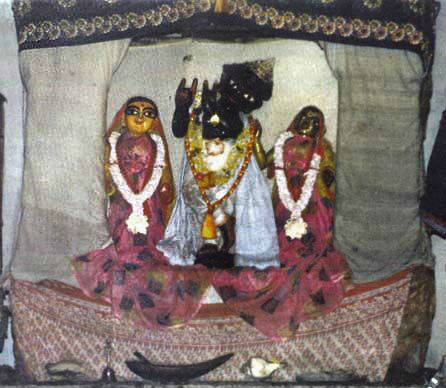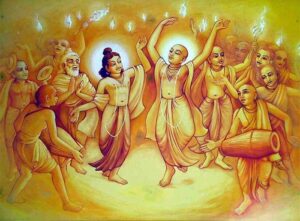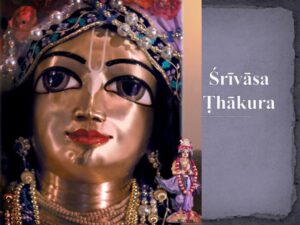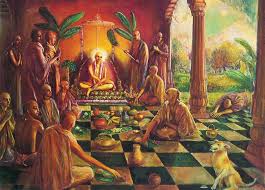Nityananda and Banka Raya – By Sri Srimad Gour Govinda Maharaja, edited and published by Sriman Madhavananda dasa in the third issue of the magazine, Sri Krishna Kathamrita.
Birth and Childhood
Nityananda Prabhu’s father’s name was Sri Hadai Ojha, and His mother’s name was Padmavati. After Nityananda Prabhu, Padmavati gave birth to another son, whom they called Banka Raya. The two brothers, Nityananda and Banka Raya, were born in the village of Ekacakra. Close to that village flows the Yamuna-nadi River. In their boyhood days, Nityananda and Banka Raya played with their friends on the bank of the river and performed various lilas there, such as krishna-lila and rama-lila.
The Meaning of Banka Raya
Banka means curved in three places, tri-bhangi. So Banka refers to Krishna, and Raya to Radharani. When both are combined, they are Banka Raya, or Gauranga. Krishna and Radha combined is Gauranga. That is the meaning of Banka Raya.
The Big Snake from Dvapara-yuga
The two brothers went to the village called Mayuresvara, the village of their maternal grandfather. Close to the village, there was a jungle. Once, when these two brothers were about to enter that jungle, two villagers debarred them, saying, “Hey, don’t go to that jungle. There is a very big poisonous snake that devours everyone who goes there. No one returns. Please don’t go.” Nityananda Prabhu did not listen and they both entered the jungle.
Confrontation with the Snake
That big poisonous snake was staying under a tamala tree, and as soon as these two brothers entered the jungle, it came out, raising its hood and hissing. Nityananda Prabhu was not afraid at all. He raised His hand and said, “Eh! Oh, wicked fellow! Dunta, stay there! Stay there! Don’t come forward!” The snake stopped. “Why are you killing and devouring innocent people?” Nityananda Prabhu is Nagaraja, the king of all snakes, Anantadev Naga, so when He told the snake to stop, he stopped. Then He continued and asked, “Why are you doing this?” The snake then related his history from Dvapara-yuga.
The Pandavas in Ekacakra
The snake said, “In Dvapara-yuga, after staying in the house of lac, the Panca Pandavas were wandering in disguise as brahmanas, begging alms from village to village. They met Vyasadeva in this Ekacakra village and Vyasadeva told them to stay in the house of a brahmana named Vedasrava. Although that brahmana was very poor and would go out to beg for alms every day, he spared half of his house for the Pandavas to live with their mother, Kunti. Every day, four of the five brothers would go out begging for alms, and one brother would remain with Kuntidevi. In this way, they took turns.
The Demon Bakasura
One day, when it was Bhimasena’s turn to stay with Kuntidevi, she heard the brahmana’s wife crying. She went to see her and asked, “Why are you crying?” The brahmani said, “There is a demon named Bakasura who lives nearby. He would come every day to this village and indiscriminately kill many animals and human beings. The villagers requested the demon not to come every day and instead offered to send one human being, one cartload of rice and cake, and two buffaloes each day. The demon agreed, and thus the villagers took turns sending food and a person to Bakasura.
Bhima Kills the Demon
It was the turn of the brahmana Vedasrava. The brahmana, his wife Umadevi, and their children arranged the offerings. When Kuntidevi saw them crying, she offered to send Bhima instead. Knowing Bhima’s strength, she assured the family that he would kill Bakasura and save the villagers.
Bhima took the cartload of food and called out to Bakasura while eating the food. The demon, enraged, fought Bhima fiercely. Bhima killed Bakasura, ate all the food, and returned with an empty cart.
Arjuna’s Snake Arrow
When Arjuna returned and learned of Bhima’s encounter with Bakasura, he set out to assist him, fearing his brother might be in trouble. On his way, he shot his naga-pasa-astra, a snake arrow, to bind the demon. When he met Bhima, Bhima informed him that Bakasura was already dead. Arjuna then found the cobra wandering and commanded it to stay under a tamala tree and only devour those who came to the tree.
Nityananda Prabhu’s Command
The snake told Nityananda Prabhu that it had been devouring those who came to the tree since then. Nityananda Prabhu commanded the snake to stay inside a hole and not harm any human beings, animals, or creatures. He promised that people would come and worship the snake and offer food. Nityananda Prabhu then took one of His golden earrings and placed it at the mouth of the hole. This earring turned into a big block of stone, and a temple was built over it. It became a holy place known as kundali-tala or kundali damana, where people offer worship and bhoga to the cobra.
Banka Raya’s Disappearance
Once, Banka Raya was overseeing the cultivation of land. He asked the laborers to take a break and rest, then he uprooted all the weeds from five hectares of land within an hour. When the laborers saw this, they informed Banka Raya’s father. Villagers and his parents went to see the miracle, but Banka Raya had disappeared.
The Murti of Bankim Deva
The villagers and his parents heard an aerial voice instructing them to find a log of wood floating on the Yamuna River on the upcoming Ekadasi. Nityananda Prabhu found the log and carved a murti of Bankabihari, Krishna, naming it Bankim Deva. He installed the murti, and a temple was built. On Nityananda trayodasi, a big fair is held in front of the temple, and it is believed that Nityananda Prabhu entered into the vigraha when he disappeared.
Reflection on the Story
Divine Play and Protection:
- The stories highlight the divine play (lila) and protection offered by Nityananda Prabhu and Banka Raya.
Devotion and Miracles:
- The devotion of Nityananda Prabhu and the miracles associated with him and his brother demonstrate the power of faith and divine intervention.
Spiritual Guidance:
- The story teaches the importance of spiritual guidance and how divine beings intervene to guide and protect their devotees.
Lessons to Be Learned
- Faith and Devotion:
- Sincere faith and devotion to divine beings can lead to miraculous protection and guidance.
- Divine Presence:
- The divine is always present and ready to assist those who call upon them with a pure heart.
- Compassion and Mercy:
- The compassion and mercy shown by Nityananda Prabhu towards the snake teach the importance of kindness even towards those who have done wrong.
- Divine Play:
- The lila or divine play of the deities is a reminder of their omnipresence and their role in the lives of devotees.
Conclusion
The stories of Nityananda Prabhu and Banka Raya are filled with divine play, miracles, and teachings of compassion, mercy, and devotion. They remind us of the power of faith and the constant presence of the divine in our lives. Through these tales, we learn the importance of devotion, the impact of divine intervention, and the everlasting guidance of spiritual beings.
4o



